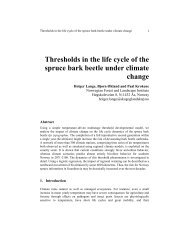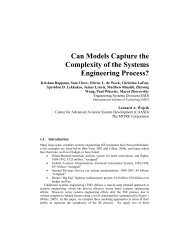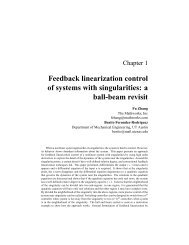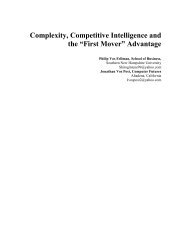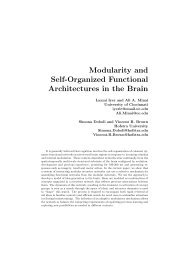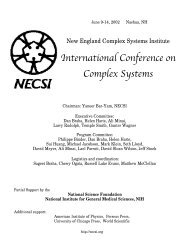the Future Map Methodology - New England Complex Systems ...
the Future Map Methodology - New England Complex Systems ...
the Future Map Methodology - New England Complex Systems ...
Create successful ePaper yourself
Turn your PDF publications into a flip-book with our unique Google optimized e-Paper software.
2<br />
decisions carry potentially high political and economic costs, <strong>the</strong>y have to be made fast<br />
and on <strong>the</strong> basis of information that is often ambiguous and rarely complete.<br />
At <strong>the</strong> same time, decision makers need to reconcile multiple, frequently conflicting<br />
internal perspectives. They have to consider options and strategies derived from<br />
organizational processes that are based on different methodologies and information.<br />
Short-term operational requirements may not be entirely consistent with long-term<br />
strategic goals. Personal agendas, experiences and value judgments play an important<br />
role, while distance, cultural backgrounds and organizational procedures create potential<br />
for “blind spots.”<br />
The characteristics of <strong>the</strong> international security environment define <strong>the</strong> need for <strong>the</strong> tools<br />
that have <strong>the</strong> potential to offer <strong>the</strong> most value for decision makers in managing<br />
uncertainties and risks [Van der Steen, 2005.] If we draw a chart that plots <strong>the</strong> degree of<br />
our understanding and predictability of <strong>the</strong> future environment against <strong>the</strong> rate of change<br />
impacting <strong>the</strong> organization, <strong>the</strong> following three situations are possible (Figure 1.)<br />
Low<br />
Random<br />
Understanding<br />
and<br />
Predictability<br />
<strong>Complex</strong><br />
High<br />
Simple<br />
Gradual<br />
Rate of Change<br />
Figure 1.<br />
Rapid<br />
Sudden changes, which we cannot predict may be considered random, as <strong>the</strong>y cannot be<br />
anticipated. Major accidents, natural disasters or terrorist acts can be placed in this<br />
category. To prepare for such situations, decision makers should focus <strong>the</strong>ir attention on<br />
developing <strong>the</strong> capacity of <strong>the</strong>ir organizations to withstand <strong>the</strong> impact of <strong>the</strong>se events as<br />
well as <strong>the</strong> capacity to mitigate and recover. Building organizational resilience is <strong>the</strong> only<br />
strategy.<br />
Predictable and gradual changes present a relatively simple challenge that organizations<br />
can handle using traditional strategic planning approaches. The development of robust<br />
models of <strong>the</strong> environment will go a long way towards improving <strong>the</strong> quality of strategic<br />
decisions. The evolution of <strong>the</strong> biggest “threat presented by <strong>the</strong> conventional and nuclear<br />
forces of <strong>the</strong> USSR” during <strong>the</strong> Cold War, as Leon Fuerth points out, was fairly gradual



